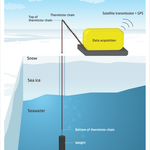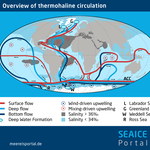Glossary
The English version of our glossary is currently under construction and will be regularly updated.
- A(31)
- B(17)
- C(44)
- D(20)
- E(30)
- F(18)
- G(15)
- H(10)
- I(27)
- J
- K(4)
- L(9)
- M(16)
- N(6)
- O(13)
- P(36)
- Q
- R(14)
- S(45)
- T(23)
- U(5)
- V
- W(3)
- X
- Y(1)
- Z(1)
- 0(2)
Tabular icebergs
Huge icebergs (in some cases with an area of several square kilometres) with a level, smooth surface, and which can extend up to 100 m above the water’s surface. Produced by calving from ice shelves.
moreTAR
The IPCC’s Third Assessment Report.
moreThermal expansion
In connection with sea level, this refers to an increase in volume (and decrease in density) due to the warming of water.
moreThermal hysteresis
Thermal hysteresis refers to the difference (hysteresis) between the melting point and freezing point of a given solution.
moreThermal infrared radiation
Thermal radiation emitted by land surfaces or objects in the longwave infrared range.
moreThermistor
Electronic component used to measure temperature changes, which it responds to by changing its electrical resistance. The name “thermistor” is derived from the words “thermal” and “resistor”. As a rule, thermistors are made of semi-conductive materials like silicon, germanium or metal oxides, and are frequently used in a broad range of applications, e.g. in air-conditioning systems, household appliances, medical equipment, and in aerospace contexts.
moreThermistor chain buoy
A buoy equipped with a thermistor chain that measures temperature distribution from the atmosphere, through the snow and sea ice, to the ocean.
more
Thermocline
Transitional water layer characterised by rapid temperature changes.
moreThermohaline circulation
Thermohaline circulation, colloquially referred to as the ocean conveyor belt, is an oceanographic circulation pattern at the surface of the ocean and in its depths. Connecting four of the five oceans, it forms a global cycle.
more
Third level consumers
Organisms in a given ecosystem that, at the 3rd level of the food pyramid, heterotrophically live off of secondary consumers, e.g. predatory fish.
moreTop-down models
Models that use macroeconomic theory, econometric and optimisation techniques in order to aggregate economic variables.
moreTotal organic carbon (TOC)
TOC (total organic carbon) refers to the total amount of carbon from organic compounds in a given sample.
moreTPES
Total primary energy supply.
moreTrace gas
All gases found in the atmosphere in lower concentrations than the three main components nitrogen (78%), oxygen (21%) and argon (ca. 1%) are referred to as trace gases.
moreTracers
Specific substances or materials used to track the transport or conversion of elements or compounds in a given ecosystem or biogeochemical cycle.
moreTree rings
Tree rings or growth rings reflect different developmental phases in a vegetation period.
moreTrend
In IPCC Reports, a trend refers to a constant change in the value of a given variable over time.
moreTrophic levels
A trophic level refers to the level or position in the food chain or food web of a given ecosystem, which is determined by the number of energy-transmitting steps that are required to reach that level (energy pyramid).
moreTropical cyclones
A tropical cyclone is a low-pressure system characterised by structured convection, severe storms, and a closed low-level atmospheric circulation at its centre.
moreTroposphere
The lowermost part of the atmosphere, from the Earth’s surface to ca. 10 km in the middle latitudes (ranging from 9 km in the high latitudes to 16 km in the tropics on average), where clouds and meteorological phenomena arise.
moreTS
(IPCC) Technical Summary.
moreTundra
Refers to a vegetation zone found in Arctic and subarctic regions and characterised by extremely low temperatures and brief vegetation periods.
moreTwo-year ice
Old sea ice that has only survived one summer melting.
more